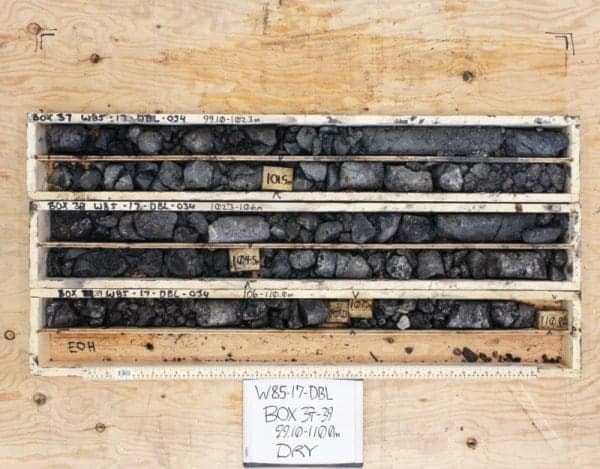The signs are looking encouraging that Pine Point may emerge sometime in the coming years as a working mine.
On April 18, Darnley Bay Resources Limited – which bought the property in December – announced the results of an independent preliminary economic assessment of the proposed project.
The assessment found what it calls a "robust economic return" with a relatively low capital cost compared to similar projects and an after-tax payback of only 1.8 years.
"I'm extremely pleased with the results," said Jamie Levy, president and CEO of the Toronto-based Darnley Bay Resources, noting that the company's staff and its engineering consultants have proved that there is potential for a very profitable mine.
John Key, Darnley Bay Resources' chief operating officer (COO), said a feasibility study will now generate more exact data than the assessment, which was put together in two or three months.
"Whenever you go into feasibility, you're looking at a year's worth of engineering to put that together," he said. "You might pull it off in nine months. Comfortably you do it in a year. There's a lot of work."
Key said the feasibility study will be a definitive document.
"It's something that you basically take to the banks to get financing with," he explained, noting that can't be done with a preliminary economic assessment.
Darnley Bay Resources is looking at starting the feasibility study in September, said Key. "That gets us into July to September of next year for a result on that feasibility."
The COO noted the project will also have to go through a land-use permit process for the open pits in the mine plan, and a water licence.
"That's a two-year process," he said. "Now if all the First Nations groups were to come on board in favour of this, there's a good chance that it could be done quicker than two years. If they decide that they're going to fight it, which we don't anticipate in any way, shape or form, but if they were to it could take longer than two years. So you really can't put a shovel in the ground and start construction until you have those two permits in hand."
The company is expected to file for the permits probably in late summer or fall of this year, and that process can proceed at the same time as a feasibility study.
If the feasibility study, permitting and financing processes all go favourably for the project, construction of a mine at Pine Point would be expected to take 12 to 18 months.
The preliminary economic assessment was prepared under the direction of JDS Energy & Mining Inc., an international engineering firm.
The study envisioned a mine as a series of 10 new open pit deposits mined in sequence.
"I'm extremely pleased that it was a decision to just use open pits," said Levy, noting an underground mine was being contemplated, but open pits are less risky and less costly.
The preliminary economic assessment also estimated a 13-year mine life with total life-of-mine production of 1.35 billion pounds of zinc and 536 million pounds of lead.
Levy said he can foresee ways to make the mine bigger with a longer lifespan.
"I think we can all envision this mine running for a lot longer than 13 years because there's more than 13 years of ore here," he said. "And I think we could increase the revenue because I think there's some higher-grade material than what we reported in this. I think we have higher recoveries than what was reported in here. So I think there could be lots of upside to this. I think the most important thing is that I'm a believer in the shortage of zinc."
The preliminary economic assessment foresees pre-production capital costs of $153.8 million.
The average workforce would be 321 persons, including staff and contractors, at full production.
A pre-concentrate will be trucked to a central 1,800-tonne-per-day milling facility. The concentrate will then be trucked to the railway in Hay River, about 65 kilometres west, from where it will be shipped to markets.
Darnley Bay Resources said it is working with First Nations to identify opportunities for employment and business.
Key noted he has face-to-face meetings with K'atlodeeche First Nation (KFN) and Deninu Ku'e First Nation (DKFN) in Fort Resolution on a monthly basis.
"We have no agreements in place at this time other than we do have a couple of agreements on sub-contracting issues," he said. "The KFN and Deninu Ku'e have signed a memorandum of understanding to where they're agreeing to work jointly to provide sub-contracting services to us."
Mayor Brad Mapes is pleased with the positive preliminary economic assessment on the project.
"I think it's great for our community and great for the region to see the interest that they've put into that property," he said of Darnley Bay Resources. "There's some challenges that they have to go forward with to make it happen, but it's great for our community and great for the region. There are hurdles that they've got to go through, but in the end I think it's something that they're up to getting it going."
Mapes noted Pine Point played a huge role in the history of Hay River.
"A large percentage of the businesses were created because of the supply needs of Cominco Mines Pine Point," he said, although he noted a new mine would never be as big as the old mine. "That's not going to happen again, but it's going to be a big plus to see some action there."
Key said he can feel real support in Hay River for bringing Pine Point back.
Cominco Ltd. operated Pine Point as a zinc and lead mine from 1964 to 1987.
